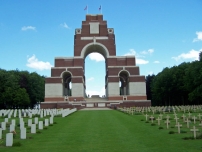| First Name: | Sidney Ernest Orme | Last Name: | ROTHE | |
|---|---|---|---|---|
| Date of Death: | 13/11/1916 | Lived/Born In: | Kew | |
| Rank: | Second Lieutenant | Unit: | Middlesex17 | |
| Memorial Site: | 1. Kew, St Anne 2. Richmond Memorial 3. Thiepval Memorial, France | |||
Current Information:Age-34 20, Maze Road, Kew 61, Defoe Avenue, Kew
The Battle of the Somme (July-November, 1916) By the beginning of November, 1916, the Battle of the Somme had been raging for four months. Thousands of men had already been killed or wounded or were simply missing, never to be seen again and just a few square miles of the French countryside, nearly all in the southern part of the battlefield, had been captured from the enemy. With November came the winter weather and this, combined with the sheer exhaustion of all involved, brought the battle to a close by the end of the month. Since the 1st July, 1916, British, Canadian, Australian, New Zealand and South African casualties numbered over 400,000, killed, wounded and missing. During November the focus of the fighting switched to the Ancre valley where the last major British offensive was launched on 13th of the month. By now German defence tactics had evolved. They defended in depth without a well defined front line but rather setting up machine-gun nests in shell holes and other strategically important sites where just a few men could hold up an entire battalion. Meanwhile their artillery bombarded the British front line and all the communication trenches added to which the weather was simply awful turning the battlefield into a morass of mud. A few gains were made such as the capture of the village of Beaumont-Hamel and some of the marshy land either side of the river, but very few of the British objectives were achieved. Once again the casualty rate soared. On 13th November, the day the Ancre offensive began, 2nd Division attacked due east along the Redan Ridge. 6 Brigade were on the left and were faced with the task of clearing the formidable German strongpoint, the Quadrilateral, before they could proceed further. But this proved to be their stumbling block. The artillery barrage had not dealt adequately with the enemy wire here and both 13th Essex and 2nd South Staffordshire, the two leading battalions, were hit by machine gun fire. Further hindered by mud and poor visibility, they went to ground. Following up were 1st Liverpool (Kings) and 17th Middlesex but by now things were becoming very confused as units strayed off course in the fog and became intermingled with each other. 17th Middlesex managed to get a few men into the German front line but here they were pinned down by concentrated machine-gun fire from the Quadrilateral and their stay was short one, By 9am, 6 Brigade were withdrawn to the British front line, leaving their many dead behind. One of these was Sidney Rothe. |
||||
| « Back to Search Results | ||||
| If you think any of the information shown here is incorrect, Click Here to submit your amends and comments | ||||




